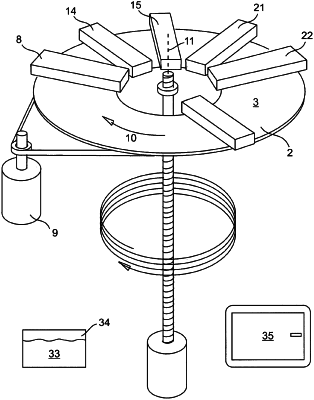| CPC B29C 64/40 (2017.08) [B29C 64/336 (2017.08); B29C 64/35 (2017.08); B33Y 10/00 (2014.12); B33Y 40/20 (2020.01); B33Y 70/10 (2020.01); B29K 2029/00 (2013.01); B29K 2033/08 (2013.01); B29K 2063/00 (2013.01); B29K 2086/00 (2013.01)] | 21 Claims |

|
1. A method for producing a three-dimensional shaped object by means of layer-by-layer material application, comprising:
a) providing geometry data for the shaped object, a support part having a base surface for holding the shaped object, a liquid or flowable first material that can be solidified, and a liquid, flowable, paste-like, or powder-form second material that can be solidified, wherein the second material comprises at least one main component that can be cross-linked by means of treatment with energy, and a latent hardener that can be thermally activated to trigger chemical cross-linking of the main component as the result of an action of heat,
b) applying material portions of the first material to the base surface, in accordance with the geometry data, to form a negative-shape layer in such a manner that the negative-shape layer has at least one cavity on a surface facing away from the base surface, wherein the at least one cavity has a negative shape of a material layer of the shaped object to be produced,
c) solidifying the negative-shape layer,
d) forming a shaped-object layer by filling the at least one cavity with the second material, such that the negative shape is transferred to the shaped-object layer as a positive shape,
e) partially cross-linking and solidifying the main component of the second material filled into the at least one cavity by treatment with energy,
f) removing regions of the solidified negative-shape layer and/or of the solidified shaped-object layer projecting beyond a plane arranged at a predetermined distance from the base surface by material removal,
g) repeating steps b) to f) at least once, wherein in a repeated step b), the first material is applied to the base surface and/or a previously formed shaped-object layer produced by steps b) to f),
h) further cross-linking and solidifying the main component of the second material forming the shaped-object layers by heat treatment, wherein the second material has a greater strength than the solidified first material and/or the partially cross-linked second material, and
i) removing the negative-shape layers from the shaped object before, while, and/or after the heat treatment is carried out.
|